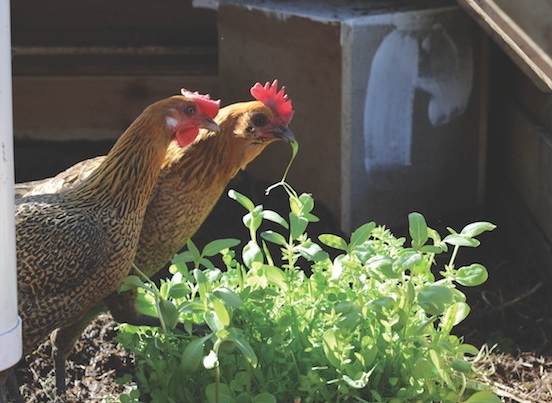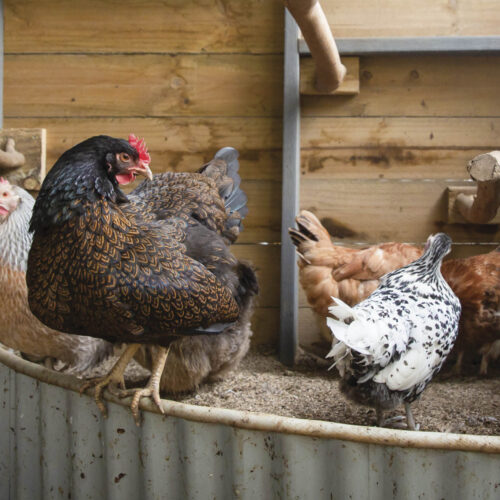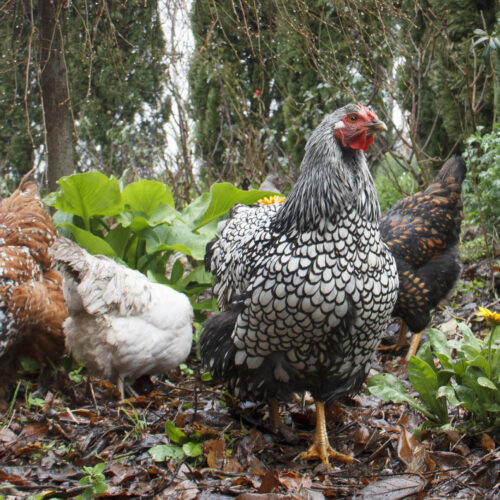Micro meals for chooks
2014-06-19T01:21:05+10:00
Microgreens may be small on size but they are big on benefits for chooks, writes PENNY WOODWARD.
My chook system involves moving the pen from one garden bed to another as crops finish so my hens have fresh ground to scratch over every few weeks. Towards the end of their stay on a garden bed, the soil has been well dug over and the waste crops have been consumed. At this point I like to give them some extra nutrition and fun with trays of microgreens.
Recent research into microgreens grown for humans showed that very young plants contain a higher concentration of nutrients than their fully grown counterparts*. You can purchase microgreen seed from seed suppliers such as Green Harvest or The Diggers Club (see ‘Resources’, p122), or make your own mix. I often use seeds such as beans, corn, brassicas, radishes and carrots that are out of date and add them to a purchased mix. If you have a larger chook pen,you could temporarily fence off a section and plant the greens there, allowing the chooks in to graze, then excluding them again to replant. I don’t have a lot of space so I grow mine in seed trays that are placed, tray and all, into the pen.
Lizzie and Jane (Campine-Old English Game crosses) peck at the green tops and then scratch out the roots, eating the lot over a day or so.
Growing microgreens
A microgreen is a young plant grown from seed that is sown, allowed to grow and then eaten while still immature. A mixture of seeds is better than growing only one type. Microgreens can be grown from any edible leafy green vegetable, herb or weed seed you have available. See ‘Suitable seeds’, opposite, for some suggestions. Once you have your seed, select a seed tray. I use both half and full-sized plastic trays that I have kept after buying seedlings for the garden.
Here’s how I do it:
1 Choose a potting mix without any water crystals or added fertiliser, and fi ll the tray to within a centimetre of the top.
2 Firm down with your hand and water.
3 Sprinkle the seed mix over the top.
4 Cover with a few more millimetres of potting mix.
5 Water again.
6 Keep the tray in a light, airy position where it will get some morning sun. Water regularly to keep the soil moist but not wet. The seeds will start to germinate after a few days, and after two weeks will form a dense mat of sprouted seedlings. I leave mine for about another two weeks when the seedlings will range in size from about 2-8cm. This is the best time to feed them to your chooks, but they can be left for up to another month if you don’t want to use them straight away. You will, however, need to keep watering them and they will also need to be watered with a liquid organic fertiliser to keep them growing strongly. I have three seed trays that I use to grow microgreens for my two chooks, and I sow them about every three weeks. As soon as they have fi nished feeding on a tray, I empty it into the compost, wash the tray, refi ll it with potting mix and re-sow with seed. So every three weeks to a month they have a gourmet feast of these nutritious greens.
Suitable seeds
Barrel medic, Medicago truncatula:
A small legume native to the Mediterranean.
Helps to maintain nitrogen levels in soil as
well as providing nutritious greens.
Buckwheat, Fagopyrum esculentum:
Grown mainly for its nutritious seed, this is
also a useful green plant.
Cabbage/broccoli and Chinese
vegetables (Brassica species): Young
seedlings are particularly high in vitamin C
and soluble fi bre as well as selenium
and carotenoids.
Chicory, Cichorium intybus: Volatile
oils in the leaves help to control internal
parasites. Some forms of chicory have been
specifi cally bred as forage plants.
Clover, Trifolium species: Especially red
and white clover, a nutritious and easily
grown forage crop.
Corn, Zea mays: Immature plants are
highly nutritious as well as containing a
natural antibiotic.
Garlic chives, Allium tuberosum: Grow
easily from seed and have some of the
same attributes as garlic, helping to control
worms and other parasites.
Linseed, Linum usitatissimum:
As well as being used for oil and fi bre
(fl ax), linseed is a useful green sprout for
stock, including poultry.
Lucerne, Medicago sativa: A wellknown
common pasture plant that also
provides nutritious greens for chooks.
Millet: Another important fodder and food
plant, the most common of which is pearl
millet, Pennisetum glaucum.
Nasturtium, Tropaeolum majus: Easy
to grow and much enjoyed by chooks. The
peppery leaves also help to control worms.
Plantain, Plantago lanceolata: This
common weed is high in protein and
minerals, as well as being tough and easy
to grow.
Radish, Raphanus sativus: Has spicy,
peppery leaves and is one of the easiest
vegetables to grow from seed, so does well
in a microgreen mix.
Silverbeet, Beta vulgaris subsp. cicla:
A well-known vegetable that is also a
useful chook food as it is high in vitamins,
minerals and protein.
Sunfl ower, Helianthus annuus: The
seeds are quickly devoured by chooks and
the seedlings are also nutritious.
*Zhenlei Xiao, Gene E. Lester, Yaguang Luo, Qin Wang. ‘Assessment of Vitamin and Carotenoid Concentrations of
Emerging Food Products: Edible Microgreens’. Journal of Agricultural and Food Chemistry, 2012; 60 (31)






